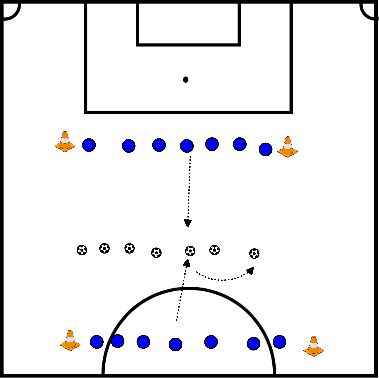Soccer drills
Dribbling exercises:
- Dribbling around the pawns, close together with 1 foot inside-outside foot
- Dribbling around the pawns, close together with 2 feet,
- going left, right foot inside foot, left foot outside side, etc.
- then to the right, left foot inside side, right foot inside side
- 4 pawns in diamond, start and go as in picture tightly past the pawns and same route back.
- Make a quadrant with 4 pawns, dribble tightly around them, left and right turns
- 8 pawns in four squares, two opposite each other.
- Dribble between the pawns from 1 to 2 and back, 1 to 3 and back 1 to 4 and back.
- On reversals cut off or behind stand leg as quickly as possible.
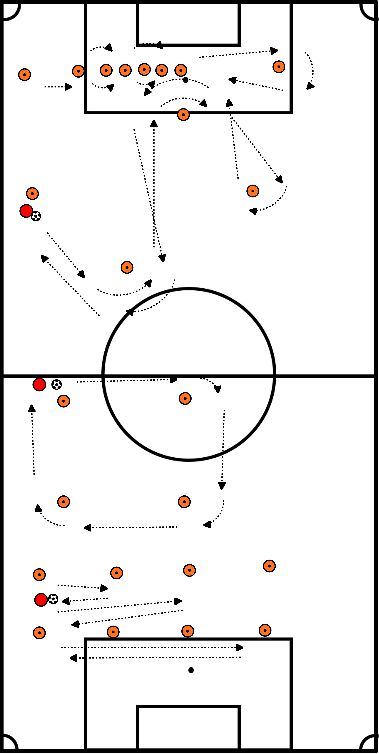
Goal:
Release ball quickly while intensity of run continues
Description:
Release ball quickly while intensity of run continues
Description:
- A plays the ball to asking B
- B rebounds the ball and then runs around the cone and offers to C
- C receives the ball from A
- C does a 1-2 with B
- C joins in behind
The exercise is performed in two groups.
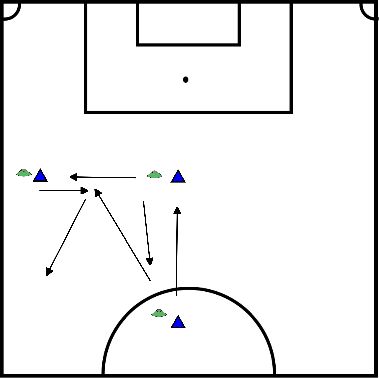
Conditional finishing in different match situations
Finishing form focused on finishing on goal.
The aim is to finish at a high tempo, while also addressing the conditional aspect.
Exercise:
Finishing form focused on finishing on goal.
The aim is to finish at a high tempo, while also addressing the conditional aspect.
Exercise:
- A dribbles to edge of 16 meters.
- A finishes.
- A sprints back to middle pylon and asks ball to B.
- B gives ball to A
- A rebounds to B.
- B works off.
- A sprints to 3rd pylon and asks ball to C.
- C rebounds ball to A.
- A gives deep ball to C.
- C sprints to side.
- C passes ball across the ground.
- A-B switch positions.
- A-B work off.
Coaching:
- Starting on time.
- Play the ball hard to the team-mate.
- Move on immediately.
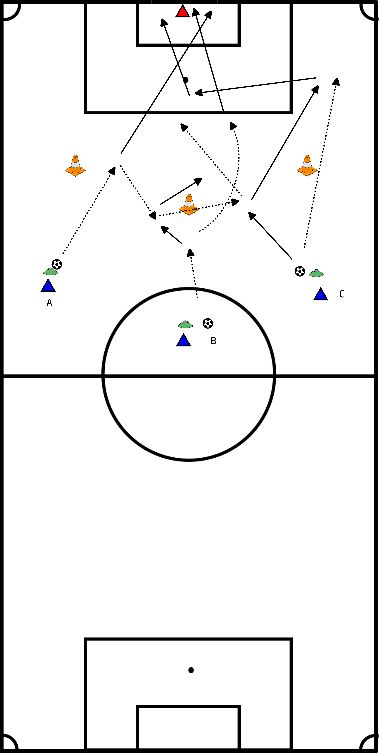
Goal:
Defenders push attackers to the side to get the shot out.
Description:
Defenders push attackers to the side to get the shot out.
Description:
- Ball always starts with attacking side.
- Attacking side starts between small goals with 4 players.
- Defending side plays with 3 players & goalkeeper.
- Attacking side tries to score as quickly as possible.
- Defenders try to prevent this by taking out the shot.
Coaching:
- Try to push the attacker to the sideline.
- Dare to put pressure forward.
- Switch sides immediately.
- Communication from the goalkeeper.
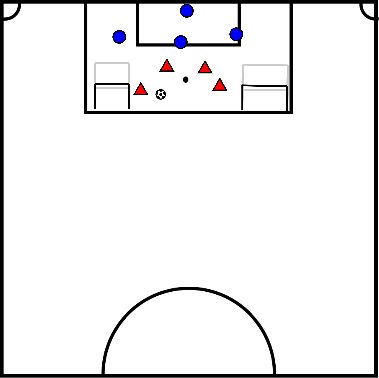
Goal:
Put intense pressure on the ball.
Conduct:
Put intense pressure on the ball.
Conduct:
- We play 4 against 4, rest of the players along the side
- 4 minutes of party play without rest
- ball out is asking players along the side
- players along the side also fetch the balls
Field size:
- 20 x 20
- 4 small goals
Coaching:
- ball out or goal, ask ball directly along side
- switch at ball loss
- direct pressure on the ball
3 variants:
- Pass with handball and then rounding left or right
- Pass with turn through pass to the left or right
- Pass with 2 bounces and then finish left or right
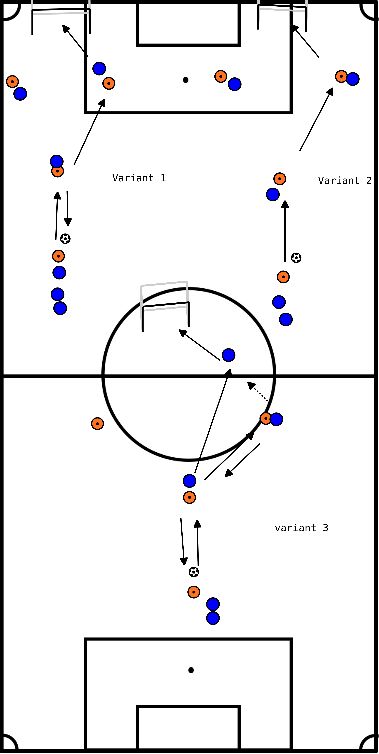
Conditional finishing with different match situations
Finishing form focused on finishing on goal.
The aim is to finish at a high tempo, while also addressing the conditional aspect
Exercise:
Finishing form focused on finishing on goal.
The aim is to finish at a high tempo, while also addressing the conditional aspect
Exercise:
- A dribbles to edge 16
- A finishes
- A sprints back to middle pylon and asks ball to B
- B gives ball to A
- A rebounds to B
- B Finishes
- A sprints to 3rd pylon and asks ball to C
- C rebounds ball to A
- A gives deep ball to C
- C sprints to the side
- C passes ball across the ground
- A-B change positions
- A-B work off
Coaching:
- start on time
- play hard on team-mate
- move on immediately
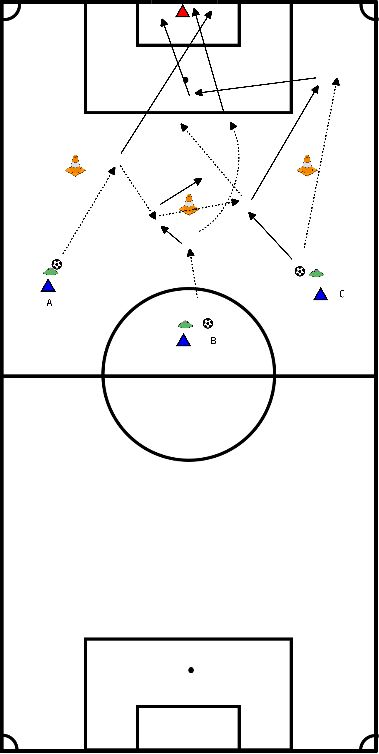
- Pass and dribble
- Player follows the ball
- Pass correctly and pay attention to 1 x hit
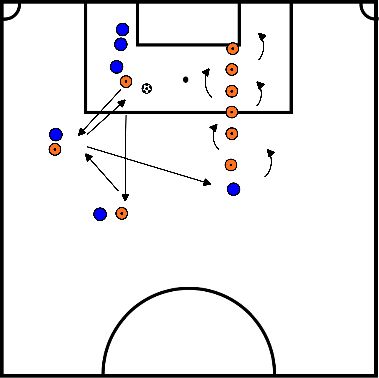
Goal:
- Improve building from behind
Contents:
- Improve building from behind
Contents:
- A does for action and asks for the ball from B
- B plays ball to A
- A plays ball to C
- D starts to run forward
- C passes ball in the run to D
- D finishes on the small goalmouth
- A = 6
- B = 3
- C = 3-4
- D = 2
Coaching:
- Communicate with your players
- Keep moving continuously
- See where your fellow players are standing
- Run on time
CAUTION!!!
Exercise is done in two groups so there is no need to stand still for long periods of time!
- Communicate with your players
- Keep moving continuously
- See where your fellow players are standing
- Run on time
CAUTION!!!
Exercise is done in two groups so there is no need to stand still for long periods of time!
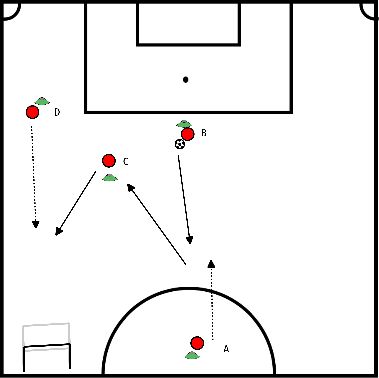
- Distances:
- Rectangle of 15 by 5 meters.
- Pawns B and C 5 meters apart.
- Both 2.5 meters from side and 5 meters from A and D.
- Duration: 10 min.
- After 5 min change direction
Explanation:
- A plays into B
- B drops the ball to C
- C passes to D
- The moment the ball reaches D, A has to be there to make the handball.
- D bounces to A and runs straight through to be played in again.
- A rebounds to D and D rebounds to E.
- E takes ball to starting point.
- Running lines: A becomes B, B becomes C etc.
Points of attention:
- Tight balls by hitting ball in heart, body slightly over ball.
- B must drop the ball on C slightly to outside so that there is a free pass line to D.
- A must time that she/he is present at the right time for the handball with D.
- If she/he is too early and has to wait too long it means in the match that there is opponent in her/his back.
- Is she/he too late D has to wait it means in the match that the opponent can put pressure on D.
- To maintain concentration make sure that at point A the ball is not played until everyone is in place.
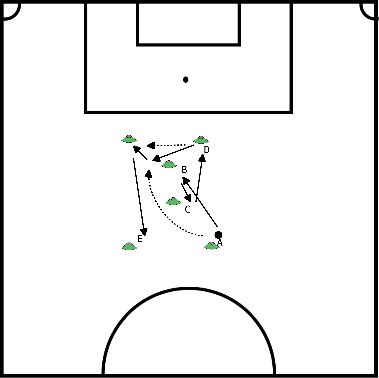
Description:
- Position play, where the overtal must put immediate pressure on ball loss
- Position play, where the overtal must put immediate pressure on ball loss
Game Shape:
- The red team plays the ball around or plays for possession.
- The blue team tries to take the ball away.
- If the blue team has gained possession of the ball, they must try to score as soon as possible in 1 of the 4 goals.
- The red team must prevent this from happening.
- We play 9 x 5.
Dimensions:
- 40x40
- 40x40
Coaching:
- Is it pressured at all when the ball is lost?
- If yes, by whom and by whom not? If no, why not?
- If pressure is applied, how? Aggressively from the idea of capturing the ball immediately or from a shuffling pace?
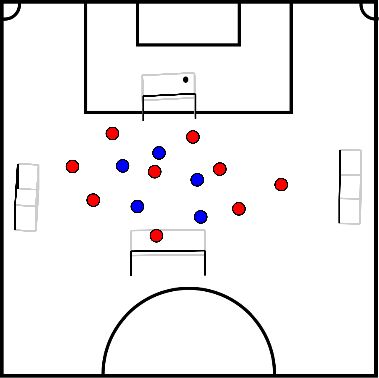
Description
- Players start at pylons
- Balls are in the middle
- Players kick in place
- When trainer calls, players go toward balls, 2-pairs at 1 ball
- Coach calls left and right, players go to that side
- When trainer calls ball, you have to take the ball with your hands
